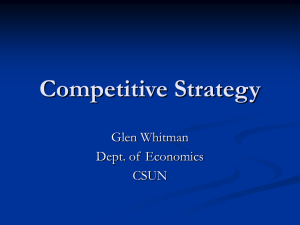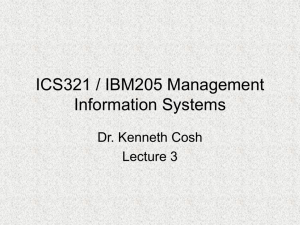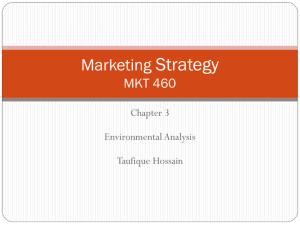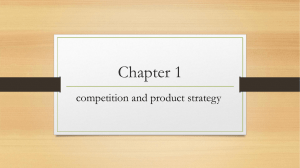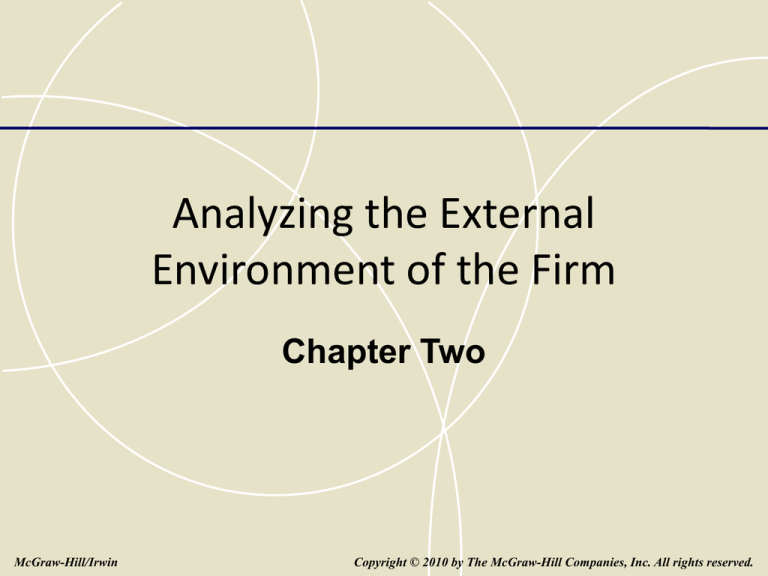
Analyzing the External
Environment of the Firm
Chapter Two
McGraw-Hill/Irwin
Copyright © 2010 by The McGraw-Hill Companies, Inc. All rights reserved.
Learning Objectives
After reading this chapter, you should have a good
understanding of:
LO1 The importance of developing forecasts of the
business environment.
LO2 Why environmental scanning, environmental
monitoring, and collecting competitive intelligence
are critical inputs to forecasting.
LO3 Why scenario planning is a useful technique for firms
competing in industries characterized by
unpredictability and change.
LO4 The impact of the general environment on a firm’s
strategies and performance.
2-2
Learning Objectives (cont.)
LO5 How forces in the competitive environment
can affect profitability and how a firm can
improve its competitive position by increasing
its power vis-à-vis these forces.
LO6 How the Internet and digitally based
compatibilities are affecting the five
competitive forces and industry profitability.
LO7 The concept of strategic groups and their
strategy and performance implications.
2-3
Creating the Environmentally
Aware Organization
2-4
Environmental Scanning & Monitoring
• External Scanning
Surveillance of a firm’s external environment:
Predict environmental changes to come
Detect changes already under way
Proactive mode
• Alerts the firm to critical trends before changes
have developed a discernible pattern and before
competitors recognize them
2-5
Environmental Scanning & Monitoring
• External Monitoring
Track evolution of environmental trends, sequence of
events or streams of activities
2-6
How to Spot Hot Trends
•
•
•
•
Listen
Pay attention
Follow trends online
Go old school
2-7
Virgin Mobile and Crowdsourcing
• Virgin Mobile USA
relies on 2,000
carefully selected
online customers,
referred to as
“Insiders” to keep it
aware of trends and
promising
opportunities.
• The Insider
community—a very
hip focus group—
provides input on
everything from
designing phones to
coming up with
names for service
plans.
2-8
Competitive Intelligence
• Define and understand a firm’s industry
• Identify rivals’ strengths and weaknesses
Intelligence gathering (data)
Interpretation of intelligence data
• Helps a firm avoid surprises
2-9
Environmental Forecasting
• Environmental forecasting
Plausible projections about direction, scope,
speed and intensity of environmental change
2-10
Environmental Forecasting
• Scenario analysis
involves experts’ detailed assessments of
societal trends, economics, politics,
technology, or other dimensions of the
external environment
2-11
QUESTION
Which of the following is a danger of
forecasting?
A. Managers assume that the world is not open to
precise predictions.
B. Managers may view uncertainty as black and
white and ignore grey areas.
C. Managers assume that the world is uncertain.
D. Managers view the world as completely
unpredictable.
2-12
SWOT Analysis
Firm’s strategy must:
• Build on its strengths
• Remedy the weaknesses or work around them
• Take advantage of the opportunities presented
by the environment
• Protect the firm from threats
2-13
SWOT Analysis
• Strengths and
weaknesses
• Internal conditions of
the firm
• Opportunities and
threats environmental
conditions external to
the firm
2-14
Example: Harley-Davidson
• Strengths
Strong & adaptable brand image
• Weaknesses
Limited ability to develop new non-traditional
products
• Opportunities
Growing leisure interest in motorcycles worldwide
• Threats
Differing foreign policies governing motorcycles
2-15
The General Environment
Factors external to an industry, usually beyond a
firm’s control
• Demographic
• Sociocultural
• Legal/Political
• Technological
• Economic
• Global
2-16
Demographic Segment
•
•
•
•
•
Aging population
Rising or declining affluence
Changes in ethnic composition
Geographic distribution of population
Greater disparities in income levels
2-17
Sociocultural Segment
•
•
•
•
More women in the workforce
Dual-income families
Increase in temporary workers
Greater concern for healthy diets and physical
fitness
• Greater interest in the environment
• Postponement of having children
2-18
Political/Legal Segment
•
•
•
•
•
Tort reform
Americans with Disabilities Act (ADA)
Repeal of Glass-Steagall Act in 1999
Deregulation of utility and other industries
Increases in federally mandated minimum
wages
• Taxation at local, state, federal levels
• Legislation on corporate governance reforms
(Sarbanes-Oxley Act)
2-19
Technological Segment
• Genetic engineering
• Emergence of Internet technology
• Computer-aided design/computer-aided
manufacturing systems (CAD/CAM)
• Wireless communication
• Nanotechnology
2-20
Economic Segment
•
•
•
•
•
Interest rates
Unemployment
Consumer Price index
Trends in GDP
Changes in stock market valuations
2-21
Global Segment
• Increasing global trade
• Currency exchange rates
• Emergence of the Indian and Chinese
economies
• Trade agreements (NAFTA, EU, ASEAN)
• Creation of WTO (decreasing tariffs/free trade in
services)
2-22
The Competitive Environment
• Competitive environment factors that
pertain to an industry and affect a firm’s
strategies
• Competitors, customers, and suppliers
2-23
Porter’s Five Forces Model
of Industry Competition
2-24
The Threat of New Entrants
• Profits of established firms in the industry
may be eroded by new competitors
• Sources of entry barriers
Economies of scale
Product differentiation
Capital requirements
Switching costs
Access to distribution channels
Cost disadvantages independent of scale
2-25
QUESTION
If you are considering opening a new pizza
restaurant in your community, what would be the
threat of new entrants? How would you evaluate
Porter’s other forces for this industry? Explain.
2-26
The Bargaining Power of Buyers
• Buyers threaten an industry by:
Forcing down prices
Bargaining for higher quality or more services
Playing competitors against each other
2-27
The Bargaining Power of Buyers
• A buyer group is powerful when
It is concentrated or purchases large volumes
relative to seller sales
The products it purchases from the industry are
standard or undifferentiated
The buyer faces few switching costs
It earns low profits
The buyers pose a credible threat of backward
integration
The industry’s product is unimportant to the
quality of the buyer’s products or services
2-28
The Bargaining Power of Suppliers
• Suppliers can exert power by threatening
to raise prices or reduce the quality of
purchased goods and services
2-29
The Bargaining Power of Suppliers
• A supplier group will be powerful when
The supplier group is dominated by a few
companies and is more concentrated than
the industry it sells to
The supplier group is not obliged to contend
with substitute products for sale to the
industry
The industry is not an important customer of
the supplier group
2-30
The Bargaining Power of Suppliers
• A supplier group will be powerful when (cont.)
The supplier’s product is an important input
to the buyer’s business
The supplier group’s products are
differentiated or it has built up switching costs
for the buyer
The supplier group poses a credible threat of
forward integration
2-31
The Threat of Substitute
Products and Services
• Substitutes limit the potential returns of an
industry
Ceiling on the prices that firms in that
industry can profitably charge
Price/performance ratio
2-32
The Intensity of Rivalry among
Competitors in an Industry
•
•
•
•
Price competition
Advertising battles
Product introductions
Increased customer service or warranties
2-33
The Intensity of Rivalry among
Competitors in an Industry
Interacting factors lead to intense rivalry
• Numerous or equally
balanced competitors
• Slow industry growth
• High fixed or shortage
costs
• Lack of differentiation or
switching costs
• Capacity augmented in
large increments
• High exit barriers
2-34
How the Internet and Digital Technologies
Influences Industry
2-35
Using Industry Analysis: A Few Caveats
• Managers must not always avoid low profit
industries
Can still yield high returns for players with sound
strategies
• Implicitly assumes a zero-sum game,
determining how a firm can enhance its position
relative to the forces
• Five Forces analysis is essentially a static
analysis
2-36
Using Industry Analysis: A Few Caveats
(cont.)
• Good industry analysis looks rigorously at the
structural underpinnings of profitability.
A first step is to understand the time horizon
• The point of industry analysis is not to declare
the industry attractive or unattractive but to
understand the underpinnings of competition
and the root causes of profitability.
2-37
The Value Net
2-38
Strategic Groups within Industries
• Two unassailable assumptions in industry
analysis
No two firms are totally different
No two firms are exactly the same
• Strategic groups
• Cluster of firms that share similar strategies
Breadth of product and geographic scope
Price/quality
Degree of vertical integration
Type of distribution system
2-39
Strategic Groups within Industries
• Value of strategic groups as an analytical tool
Identify barriers to mobility that protect a group from
attacks by other groups
Identify groups whose competitive position may be
marginal or tenuous
Chart the future direction of firms’ strategies
Thinking through the implications of each industry
trend for the strategic group as a whole
2-40

